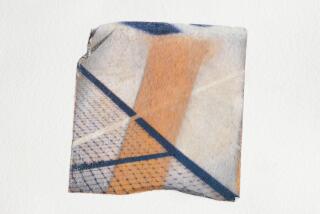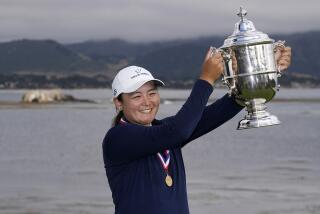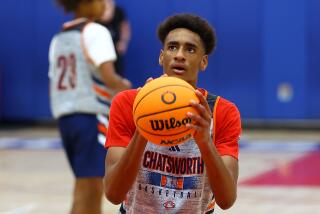Public Ambitions
Katie Mayberry of Brea Olinda High has a warning for tennis purists: Donât judge her game by the beauty of her strokes.
âI donât have a good forehand, a good backhand or much of a serve,â Mayberry said, âIâm short [5 feet 2]. I donât look all that scary. When we warm up and they see my serve, her coach will usually say, âWell, weâve got this one.â â
But often Mayberryâs more experienced opponent--the one with the textbook groundstrokes--will leave the court muttering to herself and her bewildered coach.
âSomehow, the score usually seems to go my way,â Mayberry said.
Score one for the sandlot tennis player.
Unlike baseball, basketball or football, tennis has never been much of a sandlot game. Most of the professional and highly ranked junior players started young and honed their games at country clubs, academies or their backyards, and most were helped along by private coaches or dedicated parents.
The club player and the self-taught or sandlot player use essentially the same equipment and the same rules, but they typically donât play the same game.
William Lou, girlsâ coach at Garden Grove High, said he can identify a club player within seconds.
âThese girlsâ footwork is impeccable,â Lou said. âTheir groundstrokes are beautiful. They live and breathe tennis. They have that country-club training.â
But Mayberry and Westchesterâs Cynthia Rosales are among the girlsâ tennis players throughout the Southland who are proof that not every successful player takes the conventional path. Few, if any, players like Mayberry or Rosales are threats to win City or Southern Section individual singles titles, but dozens manage to earn all-league honors despite staying outside the mainstream of the tennis culture.
The sandlot player rarely has picked up a racket until age 14. Few belong to tennis clubs or pay for private lessons, and many are introduced to the sport during summer tennis programs at a local park or their high school.
Corona del Mar Coach Tim Mang, whose girlsâ team won the Southern Section Division I title last year with an entire roster of players taking private lessons, knows what the sandlot player is up against.
âItâs tough these days for the kid who doesnât get private instruction,â Mang said. âYou can still become a good player, but you have to have one hell of a high school coach whoâs able to donate a lot of time. You also have to be a great athlete.â
Or, at the very least, have the desire to become one.
âSome kids who donât have any real tournament experience come in, make the team and have the same work ethic as the players that are already very good,â said Bud Kling, who has coached Palisades to 12 City titles in girlsâ tennis in 15 years. âTheir attitude is: âThis is what it takes to become good.â The others already have that attitude and that is why they are good.â
Rosales, a senior, adopted that can-do attitude when she went out for the tennis team at Westchester as a freshman. Like almost all of the girls at the tryout, Rosales had played little recreational tennis. Her tournament experience consisted of watching matches from Wimbledon and the U.S. Open on television.
âI had played a little bit for fun with my mom,â Rosales said. âBut I really didnât have any skills.
âI remember at the start of practice, the balls I hit were flying everywhere. But as the months and years went by, I kept working and working and my skills got better.â
Rosales made the varsity as a freshman and has been a doubles mainstay for the Comets, who are expected to challenge Fairfax and Palisades for this yearâs City title.
âOnly a few of our players have played in ranking tournaments,â Westchester Coach Sean Hanagan said. âSo the challenge is to improve the other playersâ skills to the point that when they go up against the tournament girls, they might not be able to beat them, but as a team we come out pretty successful because we do it together.â
Mayberry said her heart often goes out to the heavily favored, well-schooled opponents she beats.
âThese girls have a lot of pressure to win from their parents,â Mayberry said. âThe parents think, âWeâve spent all this money on you. You have to win.â â
Mayberry can defeat some of her opponents with a pesky approach, but she also takes her lumps.
âThere are days when I see that I could use some help, especially on my serve,â she said. âItâs so awful in comparison to my opponents. The girls who have coaches even have good second serves. Iâd settle for a good first serve.â
Mayberry tried to improve her serve. Her parents briefly hired a serving coach and they later asked if she wanted a full-time coach. Mayberry declined.
âI decided I would divide my time into other things,â said Mayberry, who has a 4.67 grade-point average and is editor of the school newspaper. âWe pretty much decided that tennis would be my fun in high school.â
Rosales takes a similar approach.
âIâm doing the best I can and the experience Iâm getting in tennis helps me know Iâm going to succeed in life,â Rosales said. âIâm just thrilled that I got so encouraged to play on the team and have become as advanced as I have.â
Rosales, Mayberry and other sandlot players who improve throughout their high school years are examples of a teaching system that works, Hanagan said.
âThe most satisfying thing you can do as a coach is to take a kid who has not been a tournament-type player and at the end of the their career, they look at you and say, âThank you very much for all of your help. Iâve really had a great time,â â he said.
âThatâs what high school sports are all about.â
*
Staff writer Gary Klein contributed to this story.
More to Read
Get our high school sports newsletter
Prep Rally is devoted to the SoCal high school sports experience, bringing you scores, stories and a behind-the-scenes look at what makes prep sports so popular.
You may occasionally receive promotional content from the Los Angeles Times.






